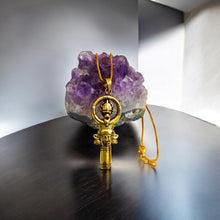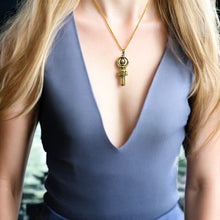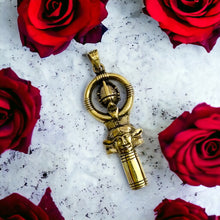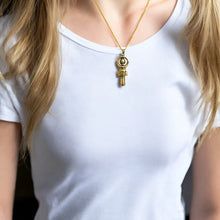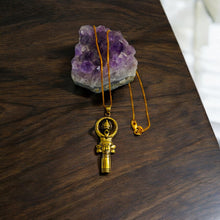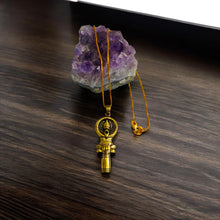
The Hathor Amulet Gold Pendant Necklace combines ancient Egyptian symbolism with modern elegance. Inspired by the goddess Hathor, known for love, beauty, and music, this pendant pays homage to the rich cultural heritage of ancient Egypt. Crafted with intricate detail, it embodies the timeless allure of Egyptian artistry, making it a symbol of beauty and grace for the wearer.
- History: Inspired by ancient Egyptian culture, particularly Hathor, the goddess of love, joy, and motherhood.
- Spiritually: Represents love, joy, and nurturing energy, invoking Hathor's divine qualities.
- Talisman: Believed to bring protection, love, and positive energy to the wearer.
- Handmade: Crafted with care and attention to detail, each pendant is unique.
- Healing: Associated with promoting emotional healing and harmony.
- Material Gold: Made from high-quality gold, symbolizing wealth, prosperity, and divine connection.
- Symbolism: Features intricate designs symbolizing Hathor's attributes and divine power.
- How to Wear: Can be worn on any chain up to 5MM (0.2 inches) in thickness, close to the heart for maximum effect.
- Ideal Gift: Perfect for someone seeking love, joy, and spiritual connection, or anyone drawn to ancient Egyptian culture and symbolism.
History Side For Those Who Are Interested
Hathor, an integral figure in ancient Egyptian mythology, represents one of the most significant and multifaceted deities of the pantheon. Throughout Egypt's long history, her influence endured, evolving and intertwining with the culture and beliefs of the civilization.
Originating in the Predynastic Period (c. 5500–3100 BCE), Hathor's earliest depictions portray her as a cow goddess, symbolizing fertility, motherhood, and nourishment. Her bovine aspect embodied the nurturing and life-giving qualities associated with bovines in the Nile Valley, crucial to agriculture and sustenance.
As Egyptian society evolved, so did Hathor's significance. During the Old Kingdom (c. 2686–2181 BCE), she gained prominence as the patroness of women, love, music, dance, and joy. Her attributes expanded to encompass the arts, beauty, and pleasure, reflecting the cultural values of the time. Temples dedicated to her proliferated across Egypt, with Dendera serving as one of the most renowned centers of her worship.
In the Middle Kingdom (c. 2055–1650 BCE), Hathor's role expanded further, incorporating aspects of a protective deity and a guide for the deceased in the afterlife. She became closely associated with the solar deity Ra, assimilating aspects of his identity as the "Eye of Ra," symbolizing his protective and destructive power.
During the New Kingdom (c. 1550–1070 BCE), Hathor's influence reached its zenith. She was venerated as the consort of the sun god Horus and considered the mother of the pharaoh, linking her to the divine legitimacy of kingship. In her role as a nurturing mother, she was often depicted suckling the pharaoh, emphasizing his divine right to rule.
Hathor's mythology also intertwined with the Osirian cycle, particularly through her association with the goddess Isis. In this context, she played a pivotal role in the resurrection of Osiris, embodying both the grief of Isis and the transformative power of rebirth.
Her iconography evolved over time, often depicted as a woman with the ears of a cow or as a cow wearing the sun disk and horns. She was also represented as a lioness, emphasizing her protective aspects, or as a sycamore tree, symbolizing fertility and rebirth.
Despite Egypt's political and cultural changes, Hathor remained a beloved and influential deity until the decline of traditional Egyptian religion in the Greco-Roman period. Her worship persisted in various forms, often syncretized with other deities, and her legacy endured through the millennia, leaving an indelible mark on Egyptian spirituality and culture.












